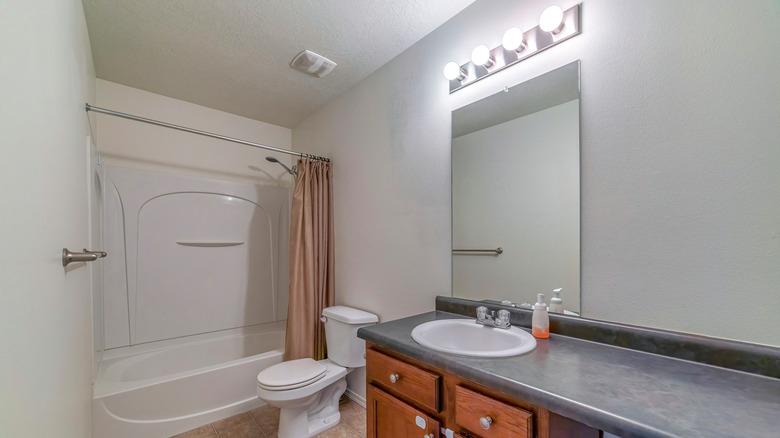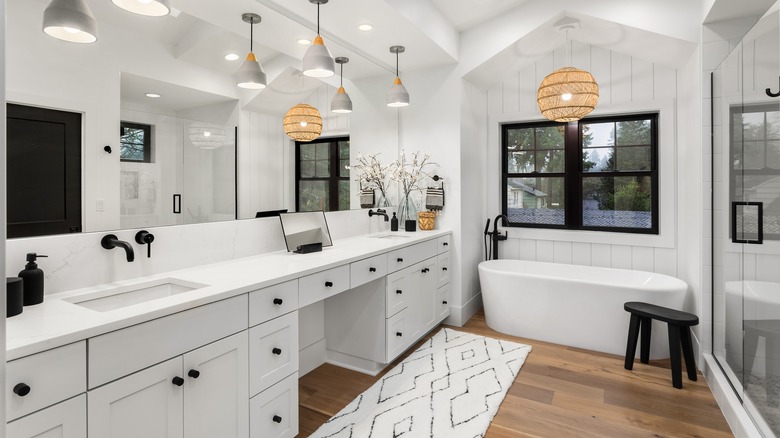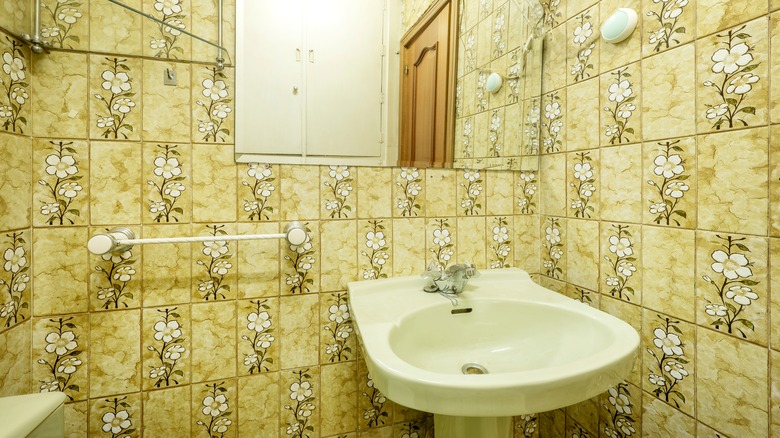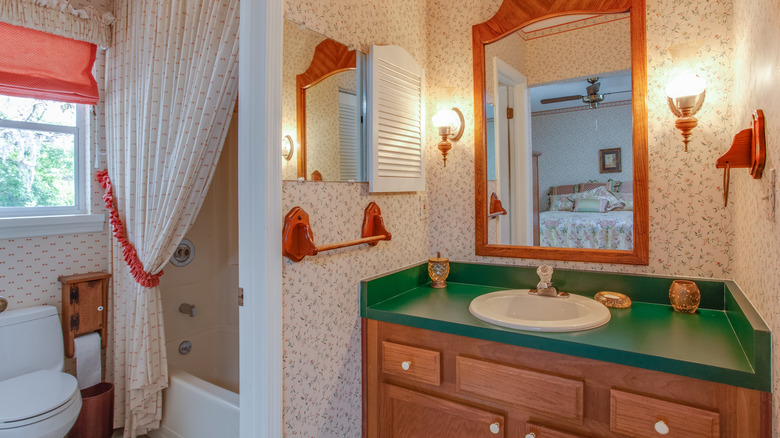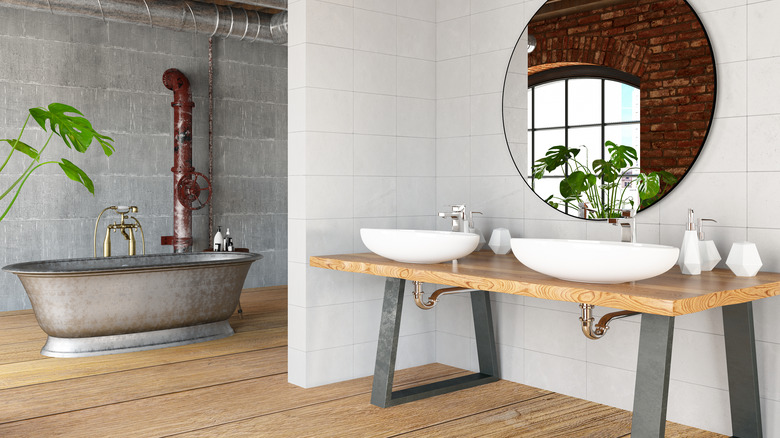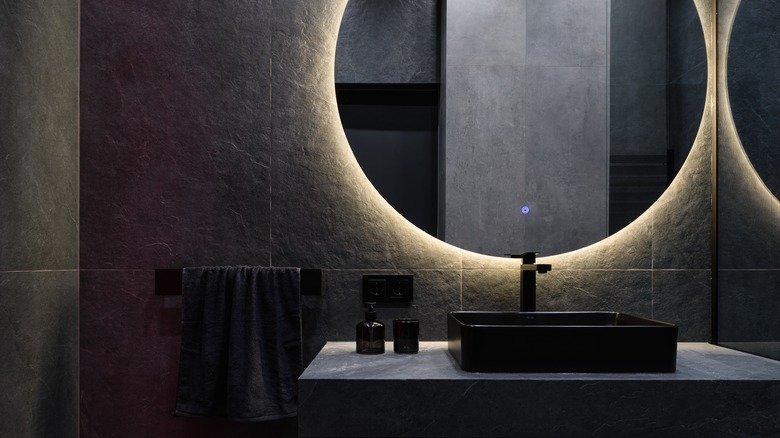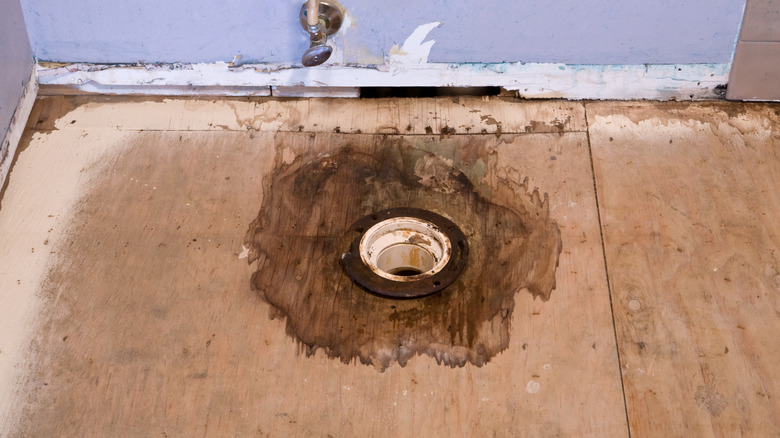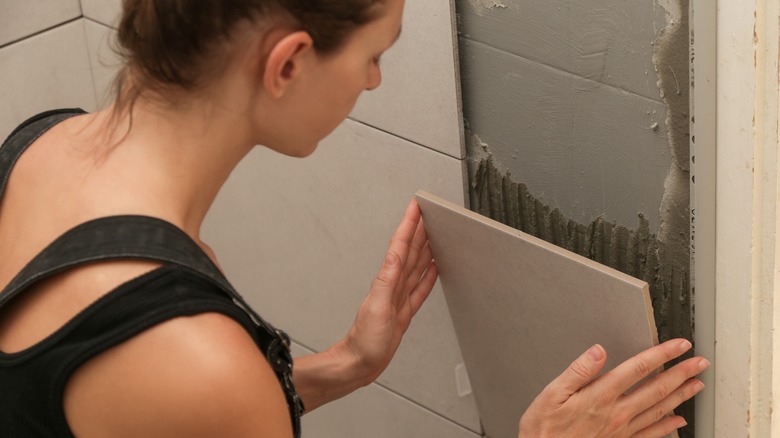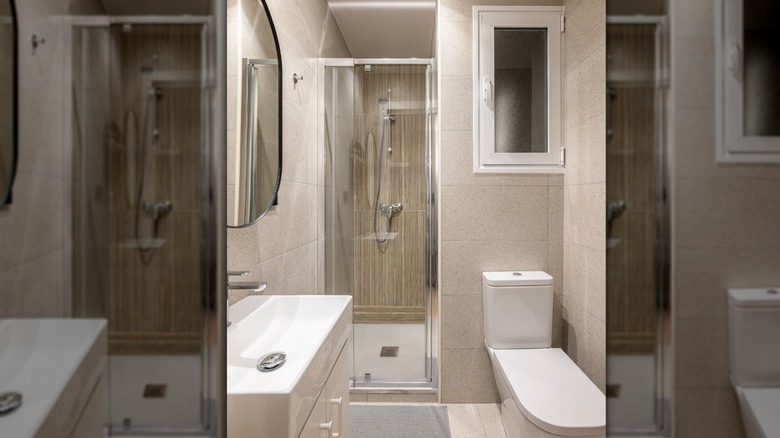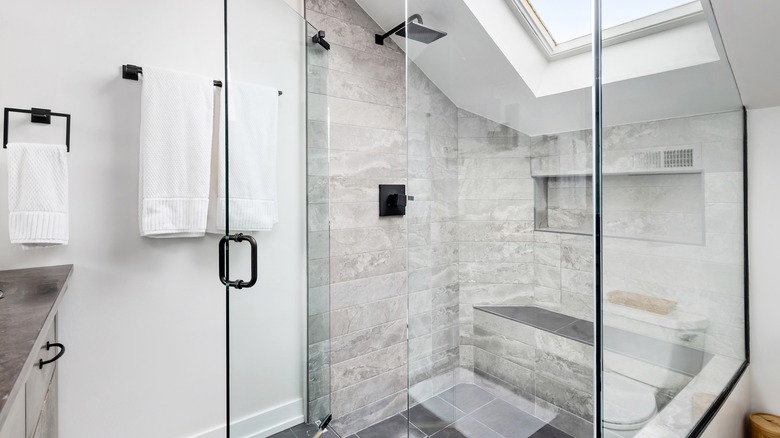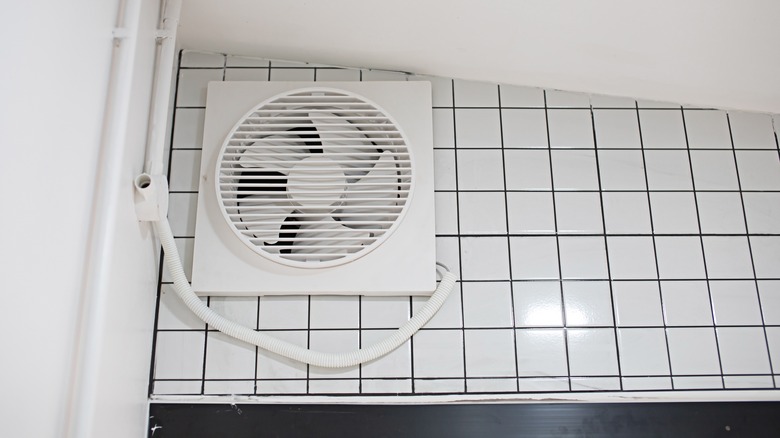Bathroom Design Choices That Make It Harder To Sell A Home, According To Experts
When touring a property, most prospective buyers pay special attention to its bathrooms. So, we reached out to some of the top real estate agents, house flippers, and experts in the industry to better understand the bathroom design choices that make it harder to sell a home.Through these exclusive interviews, we learned that bathrooms are one of the most personal spaces in the entire house. Because of this, it's important to design them with buyers in mind when preparing for a sale. You need to remove yourself from the equation and create a room that is chic, functional, and most importantly, low-maintenance. You want buyers to be able to imagine themselves getting ready in that bathroom the very next morning with as few adjustments as possible.
So yes, this means no coastal grandmother-themed bathrooms. It also means you should think twice about getting rid of your bathtub to add a bit more space, as many would prefer that it stay. And that DIY-project you have been wanting to do? Maybe it's best left to the professionals. In this House Digest exclusive, we get all of your questions answered.
Double vanities are a little too niche for secondary bathrooms
Having double vanities, sometimes called his and hers, might not be successful as a selling point in other bathrooms around the house. And, in some cases, can even be a poor choice for the master suite, too. "I get it — having your own primo vanity and grooming station separate from your partner seems like the ultimate luxury bathroom setup these days. But the tricky part arises when that sizable footprint encroaches on flow and open floor space," Ryan Fitzgerald, experienced realtor and the owner of Raleigh Realty, shared with House Digest in an exclusive interview. "Overnight guests or future owners with different needs may find those double-double setups unnecessarily obtrusive. Oversized vanities can really box you into a corner, so to speak."
Before you put your house on the market, you'll need to take a step back and examine the impact these double vanities have on the overall space in the bathroom. Is there still enough storage? Do you have to squeeze past your partner as they are getting ready in the morning? If so, it's likely you'll need to do a little demolition to make this space more appealing to the masses. Instead of bulky vanities, consider adding more built-in storage space.
Themed bathrooms limit who you can sell to
Remember those super specific themed rooms on "Extreme Makeover: Home Edition" back in the day? You cringed, knowing that as soon as the kids grew up or the trends changed that the family would no longer love the makeover. Well, it's the same for themed bathrooms in more modern times. "[These rooms] really limit your buyer pool. We all have different tastes, and what one person loves, another may hate," Eric Bramlett, Realtor and Owner of Bramlett Residential, told House Digest in an exclusive interview. "A jungle theme bathroom for example — some buyers may think that's so cool, but most will say it's just too niche for their style. It's best to go with more classic, neutral designs and colors that allow buyers to envision their own taste in the space."
In fact, all of our experts agree on this point. Don't make your bathroom too niche, even if it's not themed at all. "Those extravagantly patterned wallpapers or those vibrant, multi-colored tile mosaics you thought looked amazing during your fitting installation? They may not necessarily align with the next buyer's personal tastes — and re-doing bathrooms is pricey work," Ryan Fitzgerald said. "Keeping things relatively neutral and classic makes it much easier for prospective purchasers to envision putting their own stamp on the space." The good news is that neutral doesn't mean bland — it just means classic. Check out these bathroom remodel ideas to get started.
Outdated fixtures will turn away buyers
Bathrooms are a place that most homebuyers want to see a lot of care has gone into. These spaces are where we go to get clean, so they need to be not dirty and kept well to avoid putting people off. One of the design choices that has a tendency to scare buyers away is anything that looks like it is well past its prime. "Outdated fixtures like old, corroded faucets or yellowed lighting can give the impression of an outdated, neglected bathroom in need of upgrades," Adrian Pedraza, licensed real estate broker and owner of The California Home Buyer, a professional house-flipping company, told House Digest in an exclusive interview.
To avoid this trap, you should invest a little time and money into swapping out any bathroom fixtures that have seen better days. "In my experience, replacing fixtures can cost anywhere from $800 to $1,500 depending on the types and number of fixtures needing replacement," Pedraza shared. However, be careful not to cut corners. Just because you plan to sell the house doesn't mean you shouldn't invest in nice things. "Low-quality materials are another no-no. Things like flashy gold faucets sound nice, but if they are cheaply made, they'll just look dated fast," Eric Bramlett added. "Potential buyers will question how long appliances will last. Opt for timeless finishes like chrome or brushed nickel that have staying power. Spend a bit extra on quality shower fixtures too — it helps create a higher-end feel."
If there isn't enough storage space, you need to add more
We keep a lot of things in our bathrooms, especially personal care items. Under the sink is the de facto location for those and a lot of household cleaners, too. So when buyers are touring your home, they are going to be looking for places to keep all of this. There's one catch: They don't want to see all of your stuff. "Clutter is pretty much Public Enemy #1 when it comes to turning off prospective buyers. But tiny, minimalist pedestal sinks or loud, open-shelving concepts that leave no room for storing away everyday essentials are a surefire path to chaos," Ryan Fitzgerald told House Digest. "You'd be amazed at how many house-hunters are willing to deal with older finishes or outdated looks as long as there's ample, sensible storage to keep things feeling clean and organized."
Other experts agree, as Adrian Pedraza added, "Limited storage space is another big detractor, as buyers want room to stow all their toiletries and towels. Building out storage solutions or installing new cabinetry can easily top $1,500." You'll notice that this isn't a quick fix like popping into IKEA for a storage cart or adding a magazine basket. Those are solutions for you while you live there; you need to give potential buyers more permanent solutions to make the sale.
Darker colors can make spaces feel too cramped
Most of us will chuck a fresh coat of paint on our walls before we sell our homes. We do this to make them seem more like a blank slate and not decorated to our personal tastes. However, when repainting the bathrooms, which tend to have significantly less square feet to their name than other areas of the house, you need to be extra careful. "Dark, moody colors can work against you too. In a small bathroom especially, dark hues will make it feel cramped," Eric Bramlett said. "Buyers want light, airy spaces that have a sense of spaciousness. Light colors are usually the way to go."
Some of the most stylish bathroom paint colors include pale blues, like a powder blue for the powder room, and classic colors like gray and light brown. When in doubt, white always tends to be a great color for the bathroom. However, when choosing your white, select one with warmer undertones. This helps you avoid the sterile, hospital-like feel that can sometimes come along with the color, keeping the bathroom firmly in bright and airy territory.
Damaged floors are a dealbreaker
Your bathroom floors need to be in tip-top shape to sell your house. If they look bad, it can automatically give buyers the ick, as they will be barefoot in that room nearly every day. No one wants to feel like they need to wear shower shoes in their own house. "The biggest offender is damaged floors with cracked tiles or peeling linoleum. I once almost lost a sale because of a bathroom with a large hole in the flooring," Adrian Pedraza shared. "Replacing the floors cost me $2,000, but it was necessary to sell the home quickly. First impressions matter, and worn floors suggest problems beneath the surface."
To catch buyers' attention, the best materials for renovating your bathroom floor include natural stone tile, vinyl, porcelain, and even engineered hardwood. The key is making sure whatever option you choose is sealed properly so that it won't be susceptible to water damage since the bathroom is such a wet space. So if you do have any problem areas, it's a good idea to completely redo the floor. Since bathrooms are so small and it's unlikely that you have the original materials on hand to match any patch-ups, this makes the most logistical and financial sense.
DIY projects need to be done right to sell
We all love a good DIY project, especially after spending hours watching our fan-favorite HGTV shows. However, when trying to sell your house, your bathroom is a space where things can easily be ruined if you are not properly trained. "DIY projects gone wrong raise red flags, too. I've seen uneven tile work or mismatched finishes that were clearly amateur jobs," warned Eric Bramlett. "While the intent was good, potential buyers now wonder what else was not done to code. It's best to hire professionals for renovations if you're not an expert yourself."
So instead of having people fearing for their lives during the open house (because what if the electrical work is a shoddy DIY, too?), be realistic and stick to your skillset. If you are at the level where your DIY projects look like they belong on TV, go for it! But if you're new to the game, remodeling your bathroom when it's time to sell your house isn't the best place to cut your teeth. Hire someone for the big parts of the job and stick to the bits that have more room for a margin of error, like staging the bathroom.
Small bathing spaces will put buyers off
Bathrooms should make the most of the space they have. However, they should do so without leaving homeowners feeling like they are Will Ferrell trying to take a shower in "Elf." Bathing spaces that are too small will put buyers off. "Don't get me wrong — I absolutely appreciate thoughtful space-saving bathroom designs in more modest homes or condos. But you can take the compact living philosophy too far sometimes," said Ryan Fitzgerald. "Super-petite, practically closet-sized tubs or showers that leave you feeling cramped and claustrophobic are an immediate turn-off for many buyers seeking relaxation and breathing room, even in their smallest spaces. A little strategy with layout and fixture selection goes a long way."
However, if you think that just getting rid of one feature will save space in your bathroom, you might be making a mistake. "Removing the bathtub without replacing can limit families as buyers. Most people still want a tub, especially with young kids," Eric Bramlett warned. "At minimum keep the tub in the master if you must swap one out. That helps maintain the home's value." So if space is at a premium, secondary bathrooms with showers only are fine — but in the master, do your best to maintain the tub. While a little old school, the tub-showerhead combo is still a classic that works well in a pinch.
Spa-inspired extras might seem a bit excessive
When renovating your bathroom for sale, think more about function rather than luxury. "I love a good backyard oasis or home sauna myself as much as the next person. But when that spalike luxury starts spilling over into your bathrooms? It might be taking things a bit far in terms of mass market resale appeal," said Ryan Fitzgerald. "Those jetted tubs, rainfall shower towers, and even infrared heat lamps may seem super bougie now ... but they also run the risk of being regarded as excessive white whales by more pragmatic shoppers down the line. Not everyone shares the same 'treat yourself' design philosophy."
So instead of "oohing" and "ahhing" at the wellness center you've created in your master suite, some buyers might see those things and immediately think of the time and money that maintaining them will require. They also might wonder how much more you added to the listing price to compensate for their inclusion. "At the end of the day, creating bathroom spaces that are both highly functional and aesthetically appealing with timeless touches is the sweet spot as a seller," Fitzgerald continued. "It's absolutely possible to incorporate chic design moments and splurge-worthy amenities in smart, strategic ways. But maybe save those ultra-personal, current 'wow' statements for spaces outside the bathrooms."
Nixing the extractor fan could come back to bite you
Nothing can cramp your bathroom's style quite like a mold problem. While older homes might not have a great way to get the steam out after a long shower, no redesign is complete without adding one in. "Proper ventilation is also key to preventing moisture buildup and growth of mold and mildew," Pedraza warned our readers. "Improving exhaust fans or installing new windows for ventilation can run $1,200 to $2,500." In Pedraza's opinion, this splurge is totally worth it if you want to make the sale.
When evaluating a bathroom's design, buyers are looking for something functional and fashionable. A good moisture-wicking system is a must. Even if you have been OK with simply propping the bathroom door open during your showers, this won't fly with buyers. If you can't install a fan in the ceiling, there are also models that do better as wall mounts, too.
